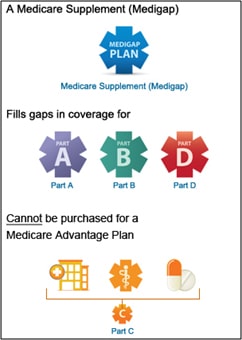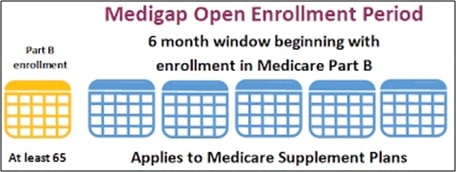Everything You Need to Know about
Medicare Supplement Plans
When you turn 65, you are eligible for Medicare, which is a health insurance plan provided by the federal government.
However, even though you are eligible and (if you have worked during your life) you and your employer have contributed a portion of your earning to pay for Medicare funding, you will still have costs associated with the program in the form of premiums.
WHAT IS MEDIGAP?

A Medicare Supplement Insurance policy (Medigap) helps pay some of the health care costs that Original Medicare doesn’t cover, specifically:
- Copayments
- Coinsurance
- Deductibles
Additionally, some Medigap policies also cover other services that Original Medicare doesn’t cover, like medical care when you travel outside the U.S.
Remember that Medigap policies are provided by third-party insurance companies. If you have Original Medicare and you buy a Medigap policy, here’s what happens when you use healthcare services:
These policies can be very helpful in mitigating many of the out-of-pocket costs that Medicare does not cover.
WHAT YOU NEED TO KNOW ABOUT MEDIGAP POLICIES
In order to have a Medigap policy, there are some things you need to keep in mind about Medigap policies:

PLANS THAT ARE NOT MEDIGAP
Just to be clear, Medigap supplements Original Medicare. The following types of insurance plans are not Medigap and should not be confused with these Medicare Supplement policies:
- Any Medicare Advantage Plan (like an HMO, PPO, or Private Fee-for-Service Plan) – remember, you can’t have Medigap and a Medicare Advantage Plan
- Medicare Prescription Drug Plans – this is Medicare Part D and must be obtained under a separate prescription drug policy.
- Medicaid – this is a health insurance plan for low-income Americans.
- TRICARE
- Veterans’ benefits
- Long-term care insurance policies
- Indian Health Service, Tribal, and Urban Indian Health plans

HOW ARE MEDIGAP POLICIES STRUCTURED?
Every Medigap policy must be structured according to federal and state laws which are designed to protect you.
All Medigap policies must first be clearly labeled as “Medicare Supplement Insurance.” Private insurance companies can only sell you “standardized” policy identified in most states by letters.

All policies offer the same basic benefits but some offer additional benefits so you can choose the policy that best meets your needs. (It’s worth noting that in Massachusetts, Minnesota, and Wisconsin, Medigap policies are standardized in a different way.)
- Each insurance company decides which Medigap policies to sell, although state laws can affect which ones they offer.
- Insurance companies don’t have to offer every Medigap plan.
- If the company offers any Medigap policy, they are required to offer Medigap Plan A, Plan C, and Plan F.
The chart below (provided by Medicare.com) compares the various Medigap plans and shows basic information about the different benefits each type of policy covers.
- Yes = the plan covers 100% of this benefit
- No = the policy doesn’t cover that benefit
- % = the plan covers that percentage of this benefit
- N/A = not applicable
| Medigap Benefits | Medigap Plans | |||||||||
|---|---|---|---|---|---|---|---|---|---|---|
| A | B | C | D | F* | G | K | L | M | N | |
| Part A coinsurance and hospital costs up to an additional 365 days after Medicare benefits are used up | Yes | Yes | Yes | Yes | Yes | Yes | Yes | Yes | Yes | Yes |
| Part B coinsurance or copayment | Yes | Yes | Yes | Yes | Yes | Yes | Yes | Yes | Yes | Yes*** |
| Blood (first 3 pints) | Yes | Yes | Yes | Yes | Yes | Yes | 50% | 75% | Yes | Yes |
| Part A hospice care coinsurance or copayment | No | Yes | Yes | Yes | Yes | Yes | 50% | 75% | Yes | Yes |
| Skilled nursing facility care coinsurance | No | Yes | Yes | Yes | Yes | Yes | 50% | 75% | Yes | Yes |
| Part A deductible | No | Yes | Yes | Yes | Yes | Yes | 50% | 75% | 50% | Yes |
| Part B deductible | No | No | Yes | No | Yes | No | No | No | No | No |
| Part B excess charge | No | No | No | No | Yes | Yes | No | No | No | No |
| Foreign travel exchange (up to plan limits) | No | No | 80% | 80% | 80% | 80% | No | No | 80% | 80% |
| Out-of-pocket limit** | N/A | N/A | N/A | N/A | N/A | N/A | $5,560 | $2,780 | N/A | N/A |
- * Plan F also offers a high-deductible plan. If you choose this option, this means you must pay for Medicare-covered costs up to the deductible amount of $2,300 before your Medigap plan pays anything.
- ** After you meet your out-of-pocket yearly limit and your yearly Part B deductible, the Medigap plan pays 100% of covered services for the rest of the calendar year.
- *** Plan N pays 100% of the Part B coinsurance, except for a copayment of up to $20 for some office visits and up to a $50 copayment for emergency room visits that don’t result in inpatient admission.
For your information, beginning January 1, 2020, all Medigap plans sold to new people with Medicare will no longer be allowed to cover the Part B deductible. Because of this, Plans C and F will no longer be available for people new to Medicare starting on January 1, 2020.
However, If you already have either of these two plans (or the high deductible version of Plan F) or you get coverage under one of these plans before January 1, 2020, then you’ll still be able to keep your plan. Also, if you became eligible for Medicare before January 1, 2020, but have not yet enrolled, you may be able to get enrolled in one of these plans.
WHEN SHOULD I BUY A MEDIGAP POLICY?
The best time to enroll in a Medigap policy is during your 6-month Medigap open enrollment period. During this enrollment period, you can purchase any Medigap policy sold in your state, even if you have health problems. The Medigap enrollment period automatically starts the month you’re 65 and also enrolled in Medicare Part B (Medical Insurance).

It’s important to know that after this initial Medigap enrollment period, you may not be able to buy a Medigap policy, or if you’re able to get one, it may cost more.
This is because Medigap insurance companies are allowed to use medical underwriting to decide whether to accept your Medigap application and how much to charge you for the policy.
However, this is not true during the open enrollment period. During this time, even if you have health problems, during you can buy any policy the company sells for the same price as people with good health.
Keep in mind that if you apply for Medigap coverage after your open enrollment period, theirs is no guarantee that an insurance company will sell you a Medigap policy if you don’t meet the medical underwriting requirements, and they are not required to sell you a policy unless you meet a specific exception.
WHAT ARE THE COSTS OF A MEDIGAP PLAN?
Because Medigap plans are administered by private insurance companies, each insurance company decides how it will set the premiums for its Medigap policies.
If you decide that you need a Medigap policy, it is important to ask how an insurance company prices its policies, because the method by which they set their premiums will affect how much you will pay for a policy now and for your policy in the future.

You should understand that Medigap policies can be priced or “rated” in 3 ways:
1Community-rated (also called “no age-rated”)
with community-rated policies usually the same monthly premium is charged to everyone who has this Medigap policy, regardless of age. This means that the price of the policy is not based on your age. Premiums may rise because of other factors, but not age
For example, if you are 72 and you pay $175/mo. for your Medigap premium. If your neighbor, who is 84 buys the same policy, he will also pay $175/mo.
2Issue-age-rated (also called “entry age-rated”)
The cost of the premium in this type of policy is based on the age you are when you buy the Medigap policy. This means that premiums are lower for people who buy the policy at a younger age and won’t change as they age.
For example, imagine you buy a policy at age 65 and it costs you $140 per month. If you wait until you are 72, the same premium may cost $175 a month.
3Attained-age-rated
The cost of the premium for this kind of policy is always based on your current age, so the premium goes up as you get older. This means that these may be the least expensive premiums at first, but may eventually become the most expensive depending on how long you live.
For example, your premiums may look something like this:
| Age | Premium Price |
|---|---|
| 65 | $120 |
| 66 | $126 |
| 67 | $132 |
| 68 | $138 |
The important thing to understand is that the cost of Medigap premiums can vary widely. There can be very big differences in the price between the policies that different insurance companies charge for exactly the same coverage.
As you carefully consider and then shop for a Medigap policy, be sure to compare the same type of Medigap policy across different insurance companies and also remember to consider the type of pricing used.
For example, you will want to compare a Medigap Plan G from one insurance company with a Medigap Plan G from another insurance company to make sure you are getting an accurate understanding of the differences in premium rates.
OTHER FACTORS IN MEDIGAP POLICY PREMIUM RATES
The cost of your Medigap premium may also depend on whether or not your insurance company offers the following discounts:
- Discounts for women, non-smokers, or people who are married;
- Discounts for paying yearly;
- Discounts for paying your premiums using electronic funds transfer;
- Discounts for having multiple policies;

Other factors that affect the premium price include:
- Whether the insurance company uses medical underwriting or applies a different premium when you don’t have a guaranteed issue right
- If you aren’t applying during a Medigap Open Enrollment Period.
- Whether the insurance company Sells Medicare SELECT policies that may require you to use certain providers. If you buy this type of Medigap policy, your premium may be less.
- Some companies offer a “high-deductible option” for Medigap Plan F. In this case, if you buy Medigap Plan F with a high-deductible option, you are required to pay the first $2,300 in 2019 of deductibles, copayments, and coinsurance not paid by Medicare before the Medigap policy kicks in to pay anything. Additionally, you have to pay a separate deductible ($250 per year) for foreign travel emergency services.
- Also, if you bought your Medigap Plan J before January 1, 2006, and it still covers prescription drugs, you would also pay a separate deductible ($250 per year) for prescription drugs covered by the Medigap policy. And, if you have a Plan J with a high deductible option, you must pay the first $2,300 in 2019 before the policy pays anything.
HOW DO I FIND A MEDIGAP POLICY?
As you can see, there is lots to understand when it comes to obtaining a Medigap policy.
There are a number of important rules and regulations that apply to getting the right Medigap for you.
As we explained earlier, there is a big difference in the prices of different Medigap policies and these premiums will vary from insurance company to insurance company.

You will want to compare plans between different companies to get the best bang for your buck.
As insurance brokers, the Medicare insurance experts at Insurance Professionals of Arizona have the ability to compare and shop the policies of many different insurance carriers.
Instead of being limited to the products of one company, we have access to many different policies. When you choose IPA Medicare agents, you get flexibility and access to the most competitive premium prices.
At Insurance Professionals of Arizona, our years of knowledge and experience in Medicare and Medigap insurance coverage, allow us to help our customers get the best policies at the best prices. Our expertise can guide you through every aspect of the enrollment process.
We are always happy to answer any questions that you might have about the Medicare or Medigap programs.
FINAL WORDS!

We can evaluate all your options with you including Original Medicare, Medicare Advantage Plans, Medigap policies, and Prescription Drug plans so that you can figure out the best way to cover your healthcare needs.
To get started, just call us or fill out the contact form on our website.
At IPA, our professional Medicare agents are here to help you navigate the Medigap options to obtain the best policy for you!
We’re here to help! Call us today.

Share your thoughts
Leave your comments